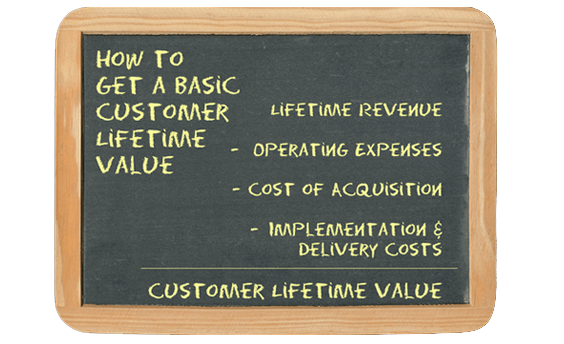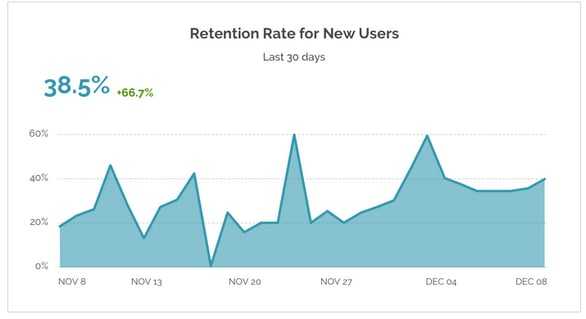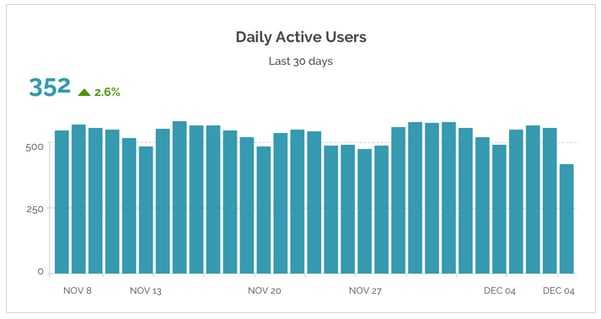Time in the app
This defines the time a user stays on your app. Time in the app is a function of session frequency and session length which tells how long users are staying in your app on a daily, weekly or monthly basis and similar to other mentioned metrics this also helps increase the understanding of the user behavior and app usage patterns.
Few questions you should ask yourself when users are not opening the app and to increase user engagement; “Are user’s screen flow similar?”, “Why are they using the app for long or short periods of time?” or “Are they just searching or also buying more?”.
Tools you can use for this:Google Analytics, AWS Mobile Analytics, Fabric
Create a moderated Office 365 distribution group
If you want to screen messages before they’re sent to the entire group, you can set up moderation rules.
-
Select Settings > View all Outlook settings > General > Distribution groups.
-
Navigate to your distribution list and select Edit.
-
Select the message approval option.
-
Check the box titled Messages sent to this group have to be approved by a moderator.
-
You can then choose group moderators for your list. Click the + icon under Group moderators: and add the appropriate contacts.
If a moderator isn’t selected, the distribution group owner will be the one to review and approve messages.
-
You can also add senders that don’t require any message approval by a moderator. This is done by choosing the + icon under Senders who don’t require message approval.
-
Click Save when complete.
Conversion
If there are any actionable features in your app like signing up, making a transaction, filling a form, giving a review, etc you’ll want to measure how many users are getting converted to goal target. Thus conversion rate is defined as the percentage of users who perform a set of goals or a specific goal that you want them to perform in your app. By calculating conversion rate at each step in your funneled data, you may know where the users are dropping off. For app tracking and conversion, tools like Apsalar and AppsFlyer can be used.
Tools you can use for this:AWS Mobile Analytics,Google Analytics, Fabric (all using custom events), Branch (referrals)
General Information
Exam Preparation
All SAP consultant certifications are available as Cloud Certifications in the Certification Hub and can be booked with product code CER006. With CER006 – SAP Certification in the Cloud, you can take up to six exams attempts of your choice in one year – from wherever and whenever it suits you! Test dates can be chosen and booked individually.
Each specific certification comes with its own set of preparation tactics. We define them as «Topic Areas» and they can be found on each exam description. You can find the number of questions, the duration of the exam, what areas you will be tested on, and recommended course work and content you can reference.
Certification exams might contain unscored items that are being tested for upcoming releases of the exam. These unscored items are randomly distributed across the certification topics and are not counted towards the final score. The total number of items of an examination as advertised in the Training Shop is never exceeded when unscored items are used.
Please be aware that the professional- level certification also requires several years of practical on-the-job experience and addresses real-life scenarios.
For more information refer to our .
Safeguarding the Value of Certification
SAP Education has worked hard together with the Certification & Enablement Influence Council to enhance the value of certification and improve the exams. An increasing number of customers and partners are now looking towards certification as a reliable benchmark to safeguard their investments. Unfortunately, the increased demand for certification has brought with it a growing number of people who to try and attain SAP certification through unfair means. This ongoing issue has prompted SAP Education to place a new focus on test security. Our Certification Test Security Guidelines will help you as test taker to understand the testing experience.
Let distribution list group members add or remove themselves
As the distribution group owner, you have the admin rights to let individual members decide whether they want to be part of your Outlook 365 distribution group or not.
-
Select Settings > View all Outlook settings > General.
-
Go to Distribution groups.
-
Click on membership approval. This will let you choose whether your approval is required to join this Office 365 distribution group.
-
Choose one of the three options available:
-
Open – Anyone can join and leave the distribution group without admin approval.
-
Closed – A member can only be added by a group owner. Requests to join are rejected automatically with this option.
-
Owner approval – Group owners can approve or reject any member requests to join the distribution group.
-
-
Click Save once you have chosen your desired option.
Lifetime value (LTV)

Last but not the least, lifetime value is THE revenue metric for looking at how well you are monetizing. It is the total revenue that you earn from a user before they stop using your app. LTV helps to find out the profit your users can generate and also predict the amount of money your app would make in the future.
LTV can be measured through a monthly average by user, which evaluates how much money that user can generate over a period of time. Also, there are formulas that can show the average revenue per customer.
Tools you can use for this: Whatever your analytics package is
Read more: User Retention in Mobile: 7 Ways to Engage and Retain App Users
Optimizing and measuring for the correct engagement metrics is the key to keeping and attaining users. If you want to know more about how to measure user engagement in your mobile app or how to make your app better based on the results, please get in touch.
Topic Areas
Please see below the list of topics that may be covered within this certification and the courses that cover them.
Its accuracy does not constitute a legitimate claim; SAP reserves the right to update the exam content (topics, items, weighting) at any time.
Product Content Management
> 12%
Introduces product modelling and catalog management, explains concept of product variants, categorization, classification and bundles, as well as the data management within product cockpit in backoffice.
-
C4H320 (SAP COMMERCE CLOUD 2205)
-
Backoffice Product Content Mgmt.
-
Working with Catalogs
-
Product Modelling
-
Synchronizing Catalogs
-
Classification
-
Modeling Product Variants
-
B2B Multi-Dimensional Products
-
Digital Asset Management
-
Configurable Bundle Module
Web Content Management
> 12%
Describes the data structure, features and functionalities, as well as the graphical user interface of web content management,(also known as SmartEdit). Also introduces the personalization module and the Composable Storefront (previously known as Spartacus).
-
C4H320 (SAP COMMERCE CLOUD 2205)
-
Overview of the CMS2 Data Model
-
Setting Up a Basic Web Site
-
SmartEdit Features
-
Personalization Module Features
-
Composable Storefront Document.
Commerce
> 12%
Identifies standard functionality available in SAP Commerce Cloud for search and navigation via SOLR, pricing, shopping cart handling, checkout types, promotions and coupons, B2B commerce.
-
Search&Navigation ModuleFeatures
-
Adaptive Search Module Features
-
Promotion Engine Features
-
Coupon Features
-
Price Calculation
-
B2B Commerce Features
-
C4H320 (SAP COMMERCE CLOUD 2205)
Essential Foundations
> 12%
Explains the typical use for Cron Jobs, impex scripts, workflow, identification of the hierarchy of users and users’ roles, validation rules. Introduces the licenses, setup and architecture of SAP commerce cloud. Includes additional knowledge about GDPR support, Intelligent Selling Services.
-
C4H320 (SAP COMMERCE CLOUD 2205)
-
Data Management with ImpEx
-
The Cronjob Service
-
Data Validation Framework
-
Workflow and Collaboration
-
Access Rights
-
Restrictions
-
SAP Commerce Architecture
-
Accelerators (B2C/B2B features)
-
Environment Components
-
Intelligent Selling Services
-
License
Order Management and Customer Support
8% — 12%
Introduces the basic order management extensions and the features of order management services module, as well as the customer support functionalities via Assisted Service Mode (ASM) and the customer support cockpit in backoffice.
-
Base Commerce Module Features
-
Order Management Features
-
Assisted Service Module Features
-
Customer Service Module Features
-
C4H320 (SAP COMMERCE CLOUD 2205)
Integrations
8% — 12%
Describes basic options for integrating SAP Commerce Cloud in general and with other SAP systems and software solutions. Understand the functionality of SAP Commerce Cloud Integration Extension Pack.
-
C4H320 (SAP COMMERCE CLOUD 2205)
-
Intro SAP Commerce Integration
-
Integration API Features
-
Cloud Hot Folders
-
SAP Commerce Integrations
-
Back-End Integration Overview
Retention

The percentage of users that return to your app in last 30 days defines retention of the app. In fact, stickiness and retention go together to see how addicted users are to your app. By making some key changes to your onboarding flow after analyzing the behavior of both who retain and who not, you can ultimately increase the retention rate. Retention, or “cohort,” tracking highlights your most valuable- and engaged- users, building better targeting opportunities and customization of the app experience. It is seen that apps retain only 40% of their initial users after a period of 30 days, on an average. As the costs for install are rising, it’s better to focus on retaining rather than acquiring.
Churn is another important metric that should be looked upon. It is that percent of users who close the app and never come back. It is just the opposite of retention rate. The drop-off in retention would tell where your users are churning. As per Flurry data, Andriod and iOS apps have a retention of 4% and hence they lose 96% users, so basically their monthly churn rate is 8% and you should target better than this for your app.
Tools you can use for this: AWS Mobile Analytics, Fabric
How to create a distribution list in Outlook Office 365
-
Launch the Outlook app launcher and navigate to the tab on the left of the screen.
-
Click on the People icon. Click on New contact and select Group.A new window will open.
-
You’ll need to give your contact group a name that’s easy to remember and search for.
We also recommend that you provide a description for your Office 365 distribution list. This lets people know what the purpose of the group is, e.g. All Users, Marketing, etc.
-
Make sure the language for all notifications is correct. By default, it will be set to the language that your Office 365 tenancy is set to.
You can also decide if members in your group will receive all group conversations in their inbox. Uncheck this box if you don’t want this to happen.
-
When you’re done, click Create.
-
Click Add when complete.
You’ve now created your first distribution list in Outlook Office 365.
This list is bound to change over time, so you might want to add/remove members. Office/Outlook 365 lets you manage your distribution lists in a variety of different ways.
It’s important to note that the person who created the distribution list is the one who owns it.
Active app users

The active user metric is different from installation and downloads metric because it sees if users are actually using the app on a regular basis rather than just downloading it. These numbers are great for giving you a baseline understanding of your app’s growth. For a better understanding of your app usage, DAU (daily active users), Weekly Active Users (WAU), MAU (monthly active users) and stickiness (DAU/MAU) are considered few critical metrics. The number of active users on your app should be higher than the new user’s number as this would indicate that there are recurring users in the app. Analytics tools have different criteria and sometimes ‘active user’ may revolve around the ‘session’, like for Google Analytics, which considers a user session only if the user opens and interacts with the app until 30 minutes of inactivity.
Stickiness is also an important factor and by knowing which features are making your app addictive or sticky, you will know the key parts of your app to drive engagement.
Tools you can use for this: Google Analytics, AWS Mobile Analytics, Fabric
Screen flow
A screen flow analysis can be used to track a total number of visits per screen, exits by the screen and the navigation flow between screens. A screen flow helps visualize the actions of your app’s users. This analysis would help you get insights on what users did on any particular screen and where they went after that. By looking at the navigation pattern of your users, you surely will get a clear sense of drop off screens, conversion road bumps and problem areas. With all this data in hand, you can create in-app marketing campaigns to get back dropped users and implement redesigns to create clearer funnels.
Tools you can use for this: Google Analytics, Mixpanel, Localytics


![Oneplus system applications update tracker [updated august, 2023]](http://toot-kak-toot.ru/wp-content/uploads/d/7/1/d71178632cc3d07457b09d7b202b610b.jpeg)
![Oneplus system applications update tracker [updated august, 2023]](http://toot-kak-toot.ru/wp-content/uploads/d/c/4/dc47bdb567bad7128fecf2318850ce85.webp)





![Oneplus system applications update tracker [updated august, 2023]](http://toot-kak-toot.ru/wp-content/uploads/2/a/2/2a24fcd36cc390babbb6b4bce0df4a26.jpeg)









![Oneplus system applications update tracker [updated august, 2023]](http://toot-kak-toot.ru/wp-content/uploads/9/1/7/9170624cce3e5079268d10c9bc30aae0.jpeg)





![Oneplus system applications update tracker [updated august, 2023]](http://toot-kak-toot.ru/wp-content/uploads/c/b/2/cb223da7616f4c75918e7da065e00e95.jpeg)



